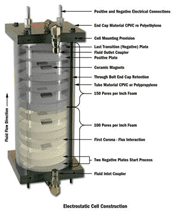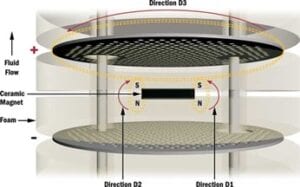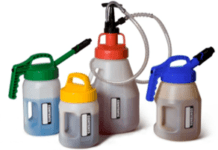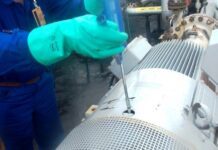
Marcos Thadeu Lobo
Mechanical Engineer Graduated from the State University Of Campinas (Unicamp) in 1985. He joined Petrobras Distribuidora S / A in 1986 as a Technical Support Professional in Products. And currently serves as a Senior Technical Consultant.
Leia em Português
Lea en español/castellano
Electrostatic filters
Electrostatic separating filters remove by-products insoluble in lubricating oil from thermo-oxidative degradation (varnish particles) and abrasive solid particulate material or submicron wear residues that are too small in size to be removed by conventional filtration systems.

 images 1/2 – Varnish and solid abrasive particulate material
images 1/2 – Varnish and solid abrasive particulate material
The solid submicron particulate material is usually polar and is naturally attracted to other polar surfaces. Varnish particles are typically polar as a result of the thermal or oxidative degradation process from which they result.
In view of this, when a polar particle passes through an electrostatic field with a high potential difference (high voltage without electric current) it is attracted to the positive or negative pole of the field, with a charge opposite to the particle’s charge, the process being similar to the of a magnet being attracted to the opposite pole of another magnet.
Images 3/4 – Operation mode of the electrostatic separator filter
There is excellent evidence that the electrostatic separator filters work very well assuming that the conditions of use are adequate, that they are properly dimensioned (the electrostatic separator filters operate in low flow and multiple passages of the lubricating oil), without the presence of water ( water compromises the electrostatic field as it conducts an electric current) and the lubricating oil does not contain dispersing detergent additives in its formulation as it keeps the contaminants in suspension.
 Image 5 – Reduction in varnish and oxidation levels
Image 5 – Reduction in varnish and oxidation levels
Advantages of electrostatic filters
The advantages of using electrostatic separating filters are not in their ability to remove solid particles, often referred to as solid particulate material, but in removing unwanted “soft” particulate material such as the by-products of the thermal or oxidative degradation of the lubricating oil. Without control, the by-products of thermal or oxidative degradation of the lubricating oil will settle on the metallic surfaces of parts such as directional valves, servo-valves, piping, plain and rolling bearings, heat exchangers, reservoirs, etc. causing deposits in the form of varnish.

 Images 6/7 – Varnish deposits on metal surfaces
Images 6/7 – Varnish deposits on metal surfaces
The use of electrostatic separating filters in “offline” filtration of lubricating oils used in industrial equipment is growing in popularity as knowledge and experience with these filtration systems is spreading.
Balance between price and performance
In the past, considered to be expensive and high-tech equipment, electrostatic filtration systems have bridged the gap between price and performance. Electrostatic separating filters are not intended to occupy the space of “in-line” filters for high mechanical pressures.
These equipments are very efficient in helping to control solid and soft particulate material when used in conjunction with conventional filtration systems, in order to avoid the deposition of lees and varnishes.
Images 8/9 – Electrostatic separator filters
This situation is particularly true in hydraulic systems and other circulatory systems subject to high working pressures where compressive heating and other stressors make degradation of the lubricating oil a real problem. Electrostatic filtration is not a single-pass technology. To achieve the lowest possible General Cleaning Level, the entire contents of the reservoir must circulate through the electrostatic separator filter for at least 24 hours.
 Image 10 – Before filtration: ISO 20/19/17; after filtration: ISO 9/5/1
Image 10 – Before filtration: ISO 20/19/17; after filtration: ISO 9/5/1
In view of the nature of the forces operating inside the electrostatic cell, the flow rates of the electrostatic filtration systems are considerably low. In typical hydraulic systems, flow rates range from 30 l / hour to 300 l / hour. However, even with very low flow rates, electrostatic filtration systems are excellent proactive solutions in maintaining the optimum condition of the lubricating oil.
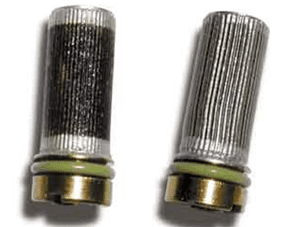 Image 11 – Servo valve before and after 45 days of electrostatic filtration
Image 11 – Servo valve before and after 45 days of electrostatic filtration
When the operating conditions are adequate, the electrostatic separating filters make excellent contributions in maintaining the general strategy of controlling contamination of the lubricating oil in industrial equipment, balancing the strategy of removing larger particulate material and water with the elimination of particulate material. solid and soft submicron, which can give rise to the formation of varnish.
#portallubes #lubricants #greases #cars #automobiles #motorcycles #trucks

